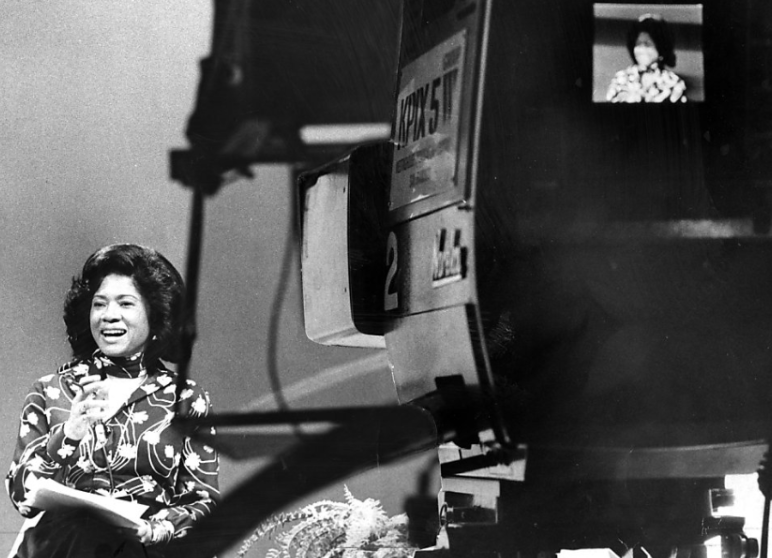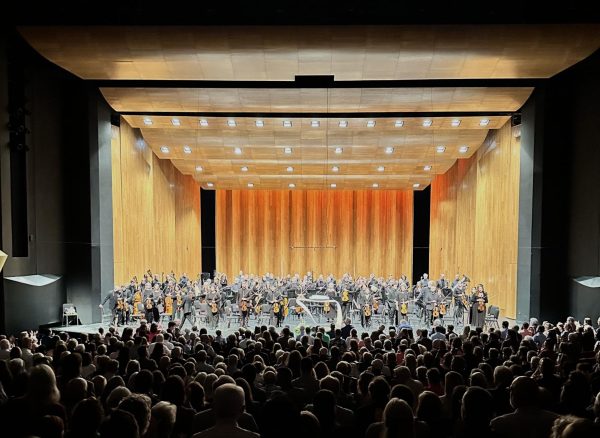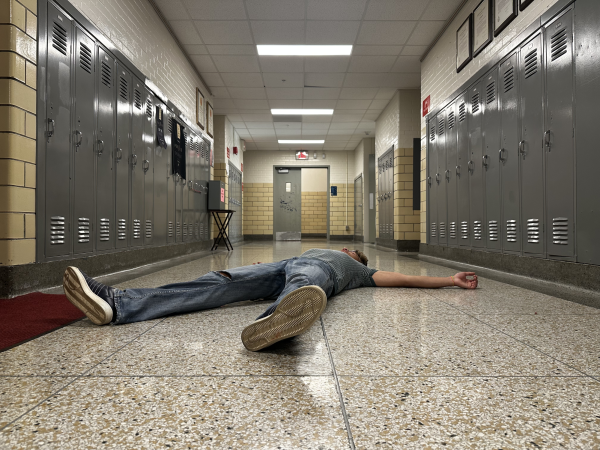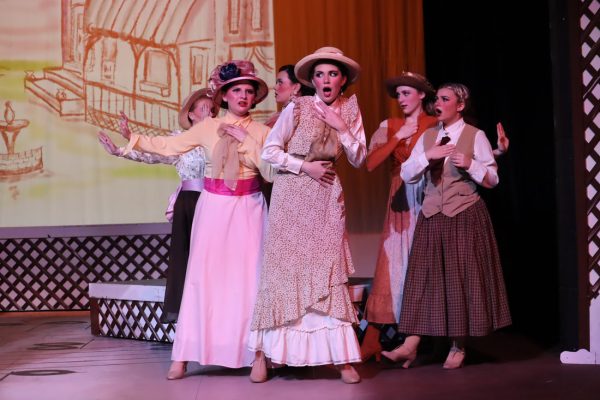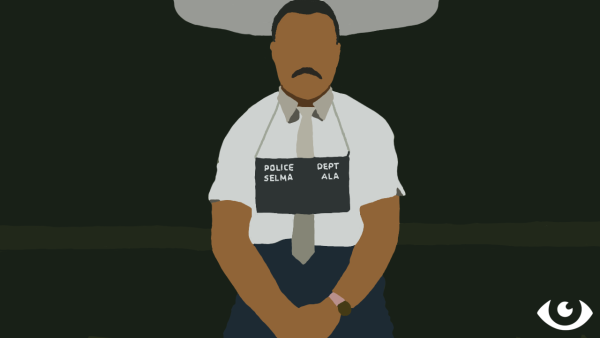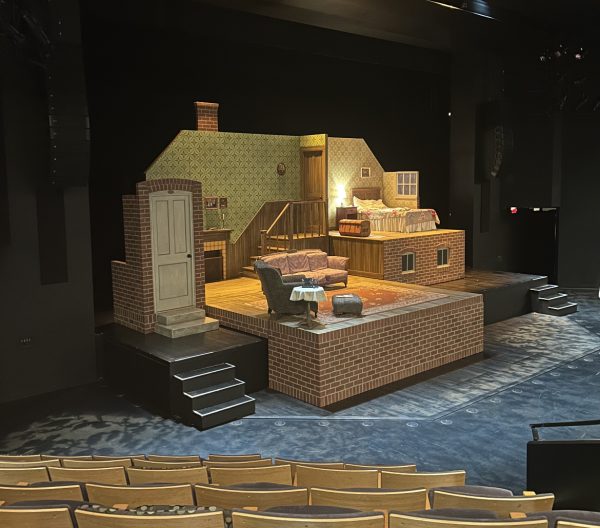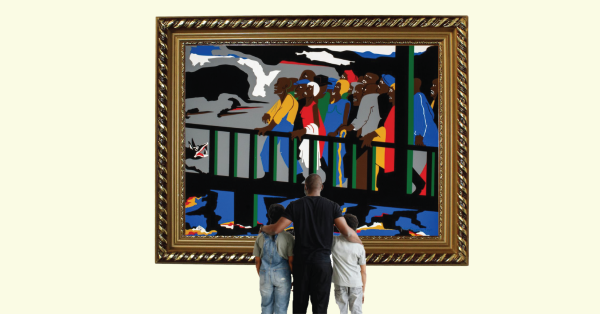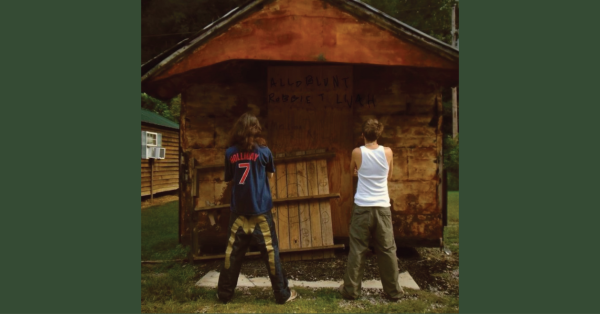WHM: How journalist Belva Davis reported her way to success
Belva Davis stands in front of the camera at KPIX’s studios, becoming the first Black female TV reporter in the western United States. Photo courtesy of Joseph J. Rosenthal via The Chronicle
March 24, 2023
“Don’t be afraid of the space between your dreams and reality. If you can dream it, you can make it so.”
And that is exactly what journalist Belva Davis did. Paving her own path in a racially segregated San Francisco during the Civil Rights Era, Davis quickly climbed her way towards success. While covering some of the most significant events in U.S. and San Francisco history, including the Berkeley protests of the Free Speech Movement, the Moscone–Milk assassinations and the AIDS and crack epidemics, Davis inspired many other journalists during and after her own career.
Born Belvagene Melton in Monroe, Louisiana on October 18, 1932, times were hard for many African American families. In the midst of the Great Depression, unemployment was high and the country was in economic, political and social turmoil. There were brutal events happening in the southern United States, including lynchings and beatings; many families felt threatened and were living in fear. After Davis’ uncle was threatened to be tarred and feathered, her family quickly moved west and eventually settled in Berkeley, California. Though Davis spent most of her first years in California living with various relatives, she was successful and excelled in school. Graduating from Berkeley High School in 1951, Davis was accepted into San Francisco State University but could not afford it. Finding a job as a copyist, Davis worked at the Naval Supply Center in Oakland.
Davis did, however, eventually find a job and her voice in Black radio at JZI, 1115, which later helped her find her first journalistic writing job as a freelance writer for Jet magazine in 1957. She later found work with several weekly black newspapers, including the Bay Area Independent and the San Francisco Sun-Reporter, editing the latter from 1961 to 1968.
In 1961, Davis became an on-air interviewer for KSAN, a San Francisco AM radio station broadcasting a rhythm and blues music format, which targeted Black listeners in the Bay Area. She also made her television debut in 1963 for KTVU, an Oakland-based television station. She then left KSAN and worked as a disc jockey for KDIA, a soul-gospel radio station, also based in Oakland. However, the 1964 Republican National Convention changed everything for Davis. Covering the event for the radio, Davis and her colleague, Louis Freeman, were driven out of the Cow Palace Hall after being taunted with racial slurs and having food thrown at them.
The outcome of this convention inspired Davis to become a reporter. “I thought to myself, watching the major media work, seeing the hatred from that floor, but seeing their power [other black reporters] to tell that story, I want to be able to tell people what happens to us,” Davis said in an interview with CBS Sunday Morning in 2014.
Though Davis had a sudden drive and passion, it was hard to find an anchor position; a lot of TV stations in the area were conflicted about hiring a Black woman. However, in 1966, as protests exploded across the country due to police brutality and harassment towards African Americans, Davis landed an on-air spot at KPIX, the CBS affiliate based in San Francisco. Believed to be the first Black female TV reporter in the western United States, Davis brought a Black woman’s perspective to stories the mainstream press often ignored.
During the early stages of her career, however, Davis was met with challenges. Because she was a woman-a Black woman at that-she was often overlooked, ignored, denied access to press conferences and insulted by other journalists, interviewees and more
“I was often asked to leave news conferences because no one [could] imagine that I was a real legitimate reporter,” Davis said.
Davis’s husband, Bill Moore, who worked as a cameraman at another nearby station, also worried about her job, citing that she was a Black woman surrounded by “a bunch of old white redneck cameramen.”
But that didn’t stop her and she never gave up her aspirations and goals as a journalist. Davis continued her broadcast work at KPIX until 1977, when she switched to KQED, an NPR and PBS affiliate, where she anchored A Closer Look and then Evening Edition from 1977 to 1981. In 1981, she then switched to the NBC affiliate, KRON, becoming an anchor and urban affairs specialist full time until 1999. There, she focused on the hot topic of police brutality by interviewing/highlighting those who had suffered an injury due to such, as well as covering the conditions of places that were directly targeted and/or affected by police brutality. Due to her extensive and continued dedicated coverage of a sensitive topic such as police brutality, Davis brought a lot of awareness to this issue long before it became a national issue.
She was bringing attention to important issues and events long before her coverage of police brutality. During the violent and nonviolent protests over the Civil Rights Movement throughout the country in the 1960s, Davis covered the Berkeley protests of the Free Speech Movement, often interviewing protestors and inserting herself into the protests and riots themselves. Inspired by the Black struggle for civil rights in the South, the Berkeley protests were a series of events at the University of California, Berkeley, and in Berkeley, California. Many of these protests were a small part of the larger Free Speech Movement, which had national implications and constituted the onset of the counterculture of the 1960s. As such, Davis was often a present face around campus due to her extensive coverage. In a clip during which the Reverend Dr. Martin Luther King, Jr. speaks at Sproul Plaza in 1967 to speak to UC Berkeley students about supporting the Civil RIghts Movement during the midst of their protests, Davis can be seen directly behind him, taking in every word.
Another big story Davis covered included the Moscone–Milk assassinations in 1978. During her coverage of this story, Davis radiated calm and comfort even during a dark time in the San Francisco community. Hosting a one hour coverage of the assassinations, Davis covered everything from the funeral service and views from inside city hall to a phone in session with then-acting Mayor Diane Feinstein and then-member Willie Brown of the California State Assembly from the 17th district. Davis covered everything for viewers and managed to keep everyone’s nerves and fears at bay.
Viewers of all races came to trust Belva Davis and she is widely regarded for her coverage of politics and issues of race and gender, as well as her calm demeanor while on-air.
Though succumbing to her age and a struggling memory, Belva Davis fought for her place in journalism and ended up creating a ripple effect, with many now-famous Black journalists and political leaders, such as now-Vice President Kamala Harris, talk show host and television producer Oprah Winfrey and CBS’ 60 Minutes anchor Bill Whitaker, citing her as their role model and inspiration.
An 8-time Emmy award winner for her journalistic role, a nationally recognized journalist, a role model to many and a leader of Black journalism, Belva Davis is now 90 years old, and still a vibrant presence in the world of journalism.


